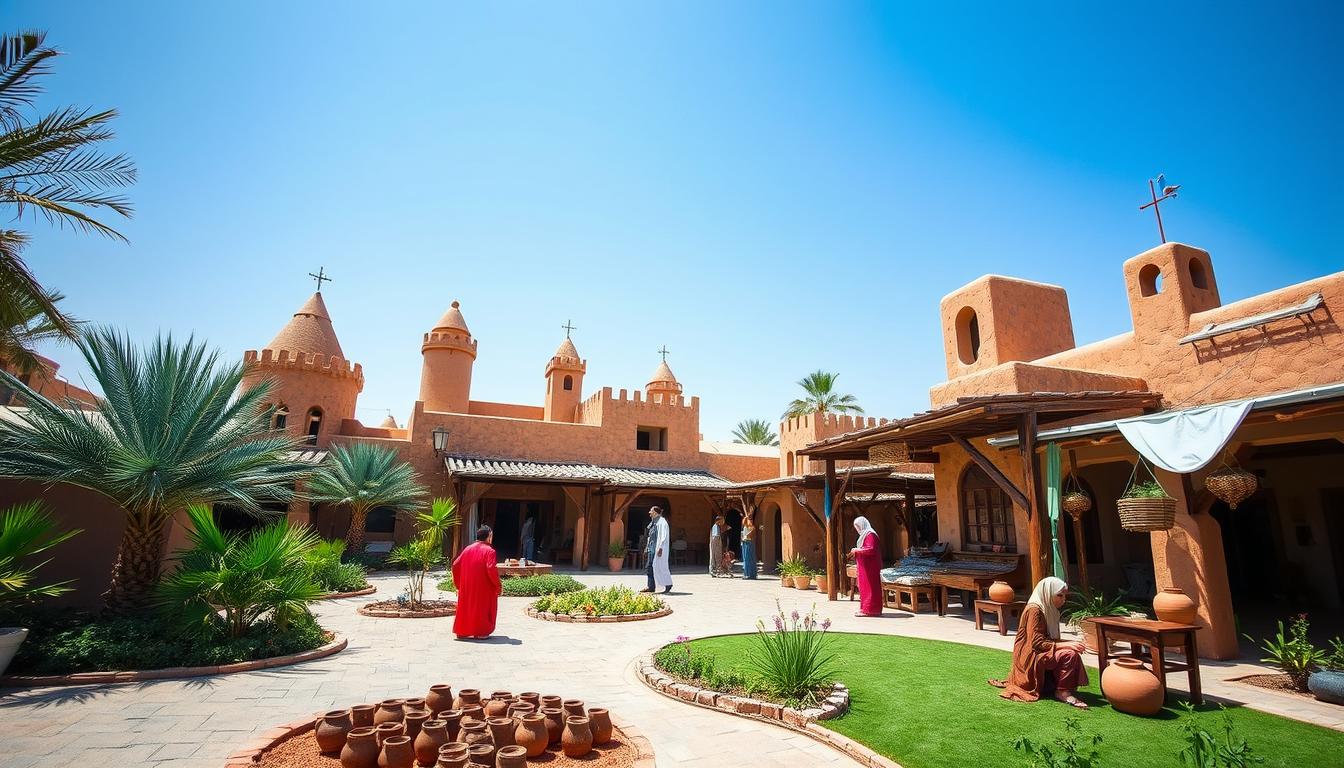
Step Back in Time at Dubai Heritage Village
Imagine standing in a place where every step tells tales of the past. At Dubai Heritage Village, you dive into Emirati culture and UAE heritage. It started in 1997. This site takes you back to a time before modern Dubai’s skyscrapers.
Here, traditional structures and crafts show a life of craftsmanship and community. The beautiful Al Shindagha Historical District sets the scene. It invites you into the rich history that shaped today’s Dubai.
Walking through this living museum, you’ll see artisans weave intricate patterns. You’ll feel the warmth of a community that has kept its identity for generations. Dubai has grown from a simple desert town to a bustling city. Yet, its heritage spirit remains strong in places like this.
Whether you’re a tourist or a local, Dubai Heritage Village offers a deep dive into the past. It celebrates the values and traditions that define this land. You’ll learn about pearl diving, crucial for Dubai’s early economy, and stories of resilience that show the Emirati spirit.
Key Takeaways
- Dubai Heritage Village is a living representation of Emirati culture and UEA heritage.
- Established in 1997, the village showcases traditional Emirati lifestyle before the oil boom.
- Visitors can engage in hands-on experiences such as pottery and weaving demonstrations.
- The village is situated in Al Shindagha Historical District, enhancing its cultural significance.
- The entrance fee is affordable, costing 60 AED for adults and 30 AED for children.
Discover the Rich History of Dubai
Dubai transformed from a humble desert community to a bustling city. It is known for cultural landmarks and economic growth. Museums and heritage sites show Dubai’s rich past. They focus on the city’s development and the pearl diving tradition.
Transformation from Desert to Metropolis
Dubai started as a trading post in the 18th century. It grew because of its location between continents. By the 19th century, it became a major trading hub. This was due to its port and trade routes.
Sheikh Rashid bin Saeed Al Maktoum invested in infrastructure and tourism. These investments transformed Dubai, bringing it into modern times. Now, places like the Dubai Museum and the Etihad Museum tell the city’s story.
Importance of Pearl Diving in Dubai’s Past
Before oil, pearl diving was key to Dubai’s economy. Divers mastered unique techniques, making the city a pearl trade center in the 19th century. This industry influenced local culture and traditions still seen in Emirati culture today.
The Pearl Museum offers a deep dive into pearl diving history. It displays artifacts and stories of this ancient trade. It shows how pearl diving helped shape Dubai.
In Dubai, you can enjoy Emirati cuisine and cultural events that showcase its rich history. Adventure seekers should try desert safaris. These tours blend heritage and thrill, showing off the desert’s beauty and culture. Learn more about what Dubai offers by visiting desert safari tours.
Understanding Emirati Culture
Emirati culture is a mix of traditions and customs showing the values and history of the Emirates people. Family is key, focusing on tight bonds and help for one another. Hospitality is also big, with everyone welcomed warmly. Keeping traditions alive is important, so future generations will know their unique culture.
Traditions and Customs of the Emirates
The Emirates have a variety of traditions, mixing old habits with new ones. Events like the Qasr Al Hosn and Sheikh Zayed Heritage Festival draw people by celebrating history and culture. They showcase traditional music, dance, and food.
The UAE has many cultural sites such as the Louvre Abu Dhabi and Zayed National Museum. The government helps keep traditions alive by building heritage villages and museums. This lets visitors have real cultural experiences. You can also try dune buggy adventures in the desert, which shows the adventurous Emirati lifestyle.
The Role of Bedouin Lifestyle in Emirati History
The Bedouin way of life deeply influenced Emirati history, showing how people adapted to the tough desert. The Bedouins lived by herding camels and trading, demonstrating their bond with the land. Their nomadic life led to a culture rich in storytelling and making things by hand, instilling key values.
Now, places like the Dubai Heritage Village let people see Bedouin traditions like weaving and pottery. These activities help visitors admire the craftsmanship of early Emirati life. By exploring these traditions, you understand the Emiratis’ strong spirit and how their past connects with today.
Exploring Traditional Architecture
Dubai Heritage Village showcases the area’s rich cultural heritage through its architecture. It features historic structures that highlight creativity and provide solutions for desert living. Among them, the Al Areesh houses and wind towers stand out for their innovation and practicality.
Significance of Al Areesh Houses
Al Areesh houses represent traditional Dubai architecture. They are made from palm fronds, aligning with sustainable practices. These homes offer shade and air flow, essential in the desert heat. Their material and design connect deeply with nature and ancestral wisdom. Visitors learn how locals designed their homes to live in harmony with the environment.
Innovative Wind Towers (Barajeel) Design
Wind towers, or Barajeel, are key features in the village. They serve as natural air conditioners by funneling breezes into buildings. This makes homes cooler without using modern AC systems. The ingenuity behind wind towers shows how past generations achieved comfort and style in harsh climates. Learning about their design gives insight into traditional architectural solutions.
Dubai Heritage Village: A Living Museum
Dubai Heritage Village is a bright spot where Emirati culture and history come alive. It was opened in 1997. Here, you can step back in time and see how traditional crafts are kept alive by skilled artisans. You can watch as they show off their skills in pottery, weaving, and metalwork. This lets you see the care and knowledge passed down through generations.
Artisan Demonstrations of Traditional Crafts
During your visit, watch local craftsmen show their skills in traditional crafts. These demonstrations give deep insights into the craft techniques and their cultural importance. They showcase Emirati heritage at its core. Talking with these artisans, you learn more about the area’s history and traditions. You see the dedication and skill that goes into their work.
Hands-on Experiences for Visitors
Dubai Heritage Village lets you dive into immersive experiences. You can try making traditional crafts yourself. Whether it’s weaving a basket or making pottery, these workshops make you appreciate Emirati culture more. Each activity connects you to Dubai’s heritage in a special way. You leave with memories and a deeper understanding of the traditions that make this place unique.
FAQ
What is Dubai Heritage Village?
Dubai Heritage Village lets you step into the UAE’s past. It’s a live museum where you can see how people lived before the oil riches. You’ll find traditional buildings and exhibits here.
When was Dubai Heritage Village established?
The village was founded in 1997. Its goal is to share and keep alive the UAE’s culture and way of life.
Where is Dubai Heritage Village located?
You’ll find it in Dubai’s Al Shindagha Historical District. This area adds a beautiful setting for learning about the UAE’s heritage.
What can I learn about Emirati culture at the village?
The village teaches about Emirati traditions. It covers family values, hospitality, and customs. You’ll also learn how the Bedouin lifestyle influenced Emirati history.
Are there any activities for visitors at Dubai Heritage Village?
Yes, there’s a lot to do. Visitors can take part in workshops and watch artisans at work. You can also try making pottery and weaving.
What types of traditional architecture can I see in the village?
You’ll see classic desert homes. There are Al Areesh houses built from palm fronds and wind towers called Barajeel. These designs were made for desert living.
Is there a focus on artisan skills at Dubai Heritage Village?
Definitely. The village shines a light on traditional crafts. Visitors can see how textiles and pottery are made. These skills are key to Emirati cultural identity.
How does Dubai Heritage Village reflect the transformation of Dubai?
The village shows Dubai’s growth from a small trading hub to a big city. It has exhibits on important industries, like pearl diving, that shaped Dubai.


